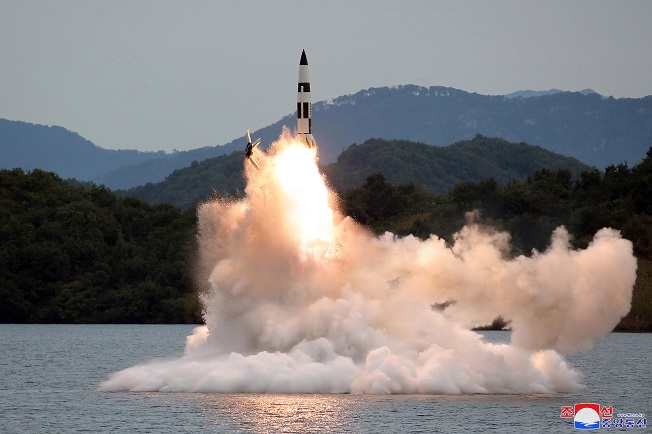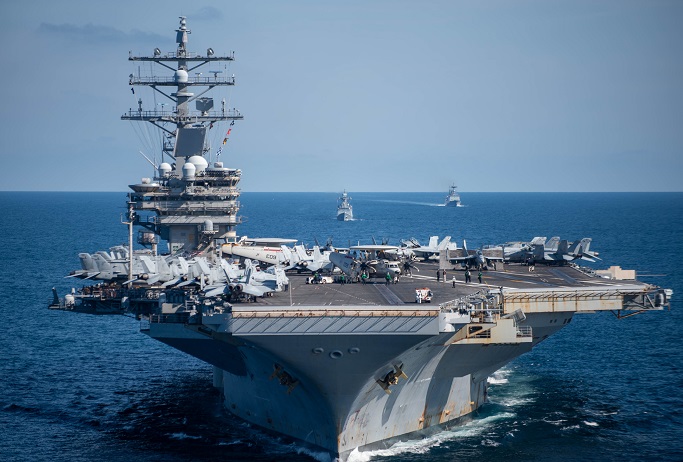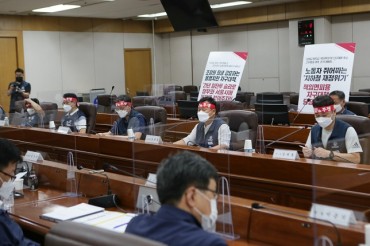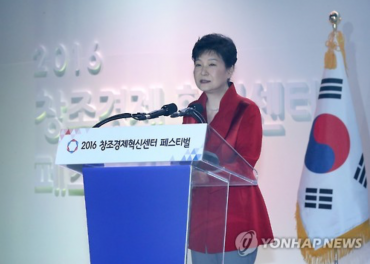
This photo, released by North Korea’s Korean Central News Agency on Oct. 10, 2022, shows a missile launched from an underwater platform in the North. (Yonhap)
SEOUL, Oct. 11 (Korea Bizwire) – North Korea appears to be shifting its focus to the development of “tactical” nuclear arms mountable on new hard-to-detect launchers, including a reservoir silo, in a bid to counter evolving South Korea-U.S. deterrence capabilities, analysts said Tuesday.
On Monday, the North announced flamboyantly through its state media that leader Kim Jong-un inspected a recent spate of major military drills, involving units tasked with operating tactical nuclear weapons, and revealed a scheme to build a missile silo under a reservoir.
The exercises, featuring ballistic missile launches and even the simultaneous mobilization of around 150 warplanes, came partly in response to the deployment of the USS Ronald Reagan aircraft carrier for allied drills in the East Sea, a demonstration of strengthened joint deterrence efforts by Seoul and Washington, according to the Korean Central News Agency.
The South has also been pushing to reinforce its independent “three-axis” deterrence system, including the Kill Chain preemptive strike platform featuring high-end detection and precision strike assets.
Then came Pyongyang’s calibrated move to show that its drive for tactical nukes and novel launchers is not empty talk, analysts said.
“North Korea is obviously trying to counter the developing ROK and U.S. ‘kill-chain’ capabilities,” Bruce Bennett, a senior researcher at the U.S.-based RAND Corp., said, referring to South Korea by its official name, the Republic of Korea.
“If the North puts underwater platforms in reservoirs for launching ballistic missiles, the ROK and U.S. would have a new challenge for locating North Korean nuclear weapon delivery means,” he added.

This photo, released by the Korean Central News Agency (KCNA) on Oct. 10, 2022, shows North Korean leader Kim Jong-un overseeing his military’s major training. The agency reported that Kim inspected an exercise of tactical nuclear operation units to assess the “war deterrent and nuclear counterattack capabilities” in response to recent joint drills by South Korea and the United States. (Yonhap)
The North has been pushing for new missile launchers, including railway-borne and road-mobile ones, as Seoul is pushing to bolster precision strike capabilities based on high-tech intelligence, reconnaissance and surveillance assets for detecting and targeting hostile targets.
Pyongyang’s pursuit of operational tactical nuclear arms is adding further complexities to the allies’ deterrence efforts, analysts said.
Tactical nukes refer to battlefield weapons with yields of around 15 kilotons — equivalent to 15,000 tons of TNT.
They are less powerful than high-yield “strategic” nuclear arms — usually carried by intercontinental ballistic missiles (ICBMs), submarine-launched ballistic missiles (SLBMs) or long-range bombers — but are still menacing for battlefield operations.
The North’s focus on tactical nukes appears to highlight its capabilities to attack the core U.S. allies — the South and Japan — and show it still has a formidable military edge even though it has a ways to go to master ICBM or SLBM technologies, analysts said.
“The North appears to seek a balance of nuclear power with steps that can hold the region hostage, amid its difficulties in fully securing ICBMs and SLBMs to attack the U.S. mainland,” Park Won-gon, a professor of North Korea studies at Ewha Womans University, said.
Bennett echoed his view.
“(North Koreans) are likely hoping to divert U.S. attention from their ICBM development until they have enough to threaten the U.S., and they have so many that the U.S. can’t take them out with a basic strike package,” he said.
“By threatening South Korea, they still command U.S. attention.”

The USS Ronald Reagan aircraft carrier sails during a naval exercise with the South Korean Navy in the East Sea on Sept. 29, 2022, in this photo provided by the Navy.
The consequential question at the moment is whether Seoul and Washington are ready to deter Pyongyang’s tactical nuclear threats when the regime was not deterred from conducting missile provocations even in the presence of the aircraft carrier, a symbol of American naval might.
Experts answered that question, citing historical examples, like those from the Cold War during which the world enjoyed a “long peace” under a delicate balance of nuclear power between the U.S. and the then Soviet Union.
During the Cold War, there were a series of conventional conflicts, including proxy wars between the two major powers, but no nuclear conflagration flared up.
“America’s extended deterrence is not to deter provocations but to deter the North’s use of nuclear arms,” a security expert told Yonhap, requesting anonymity. “That deterrence worked during the Cold War as you can see there was no use of nukes.”
Extended deterrence means the U.S.’ commitment to using a full range of its military capabilities, including nuclear options, to defend its ally.
Seoul officials voiced confidence that the South Korean military is capable of detecting and intercepting the North’s newly revealed strike and delivery assets.
“We believe (the missile fired from a reservoir silo) is a desperate measure contrived by the North that is considerably cognizant of our Kill Chain capabilities,” Col. Kim Jun-rak, the spokesperson of the Joint Chiefs of Staff, told a regular press briefing.
(Yonhap)






